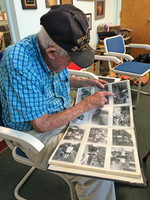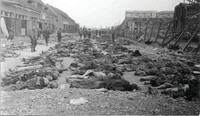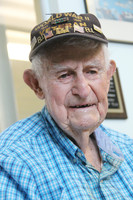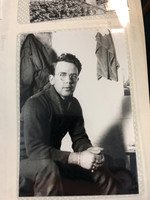By ETHAN HARTLEY -- In the Aug. 23 edition of the Beacon, Pilgrim High School senior Marcus Prezioso penned a story on his great-grandfather, Edward Hayes Jr., a U.S. Army veteran of World War II whose legacy was revealed after many decades of secrecy...
This item is available in full to subscribers.
We have recently launched a new and improved website. To continue reading, you will need to either log into your subscriber account, or purchase a new subscription.
If you are a current print subscriber, you can set up a free website account by clicking here.
Otherwise, click here to view your options for subscribing.
Please log in to continue |
|




In the Aug. 23 edition of the Beacon, Pilgrim High School senior Marcus Prezioso penned a story on his great-grandfather, Edward Hayes Jr., a U.S. Army veteran of World War II whose legacy was revealed after many decades of keeping silent about what he had experienced and seen during those years in a Europe beset by destruction.
Marcus told the story based on the best of his ability to piece together facts through photographs and letters his late great-grandfather kept following his return from the war. He emphasized that not even his grandparents knew very much about their father’s time in the service, so anything he was learning was still rife with mystery.
However, sometimes breaking the ground on history that otherwise may have gone untold and forgotten – a service Marcus carried out nobly – leads to an unexpected deluge of new information that helps provide lined structure to otherwise amorphous memories.
This is exactly what happened when Private First Class Sanford M. Tanner walked into the Beacon office Tuesday and revealed something utterly incredible. He was in the same platoon of the exact same company – the 663rd Engineer Topographical Company – as Hayes, and he was the one who took the many photos featured in the Beacon edition that were attributed to Hayes.
Tanner said that he had film shipped to him while overseas by his mother, which was almost impossible to obtain in Europe at the time. Unable to send finished film rolls back to the States due to a nationwide censorship on such materials, Tanner had to hold onto the rolls and simply hope for the best. Upon his return, he developed the film and distributed copies of some photos to his fellow soldiers, including Hayes. Tanner said he kept the negatives and still holds onto them.
Then, Tanner came across the story.
“I was sitting at Conimicut Point having a sandwich,” recalled Tanner on reading the story in the Beacon recently, “and I saw ‘663rd’ and I dropped everything and said, ‘Oh my goodness, it’s Ed.’”
Tanner, who will turn 98 this year on Christmas (yes, he was born on Christmas), had driven himself to the office and carried with him two large photo albums chock full of beautifully sharp photographs that he took while deployed during the war.
Included in the album were shots of Hayes, other squad-mates, landscapes of war-torn Europe and the grim scene of the same concentration camp that Hayes had removed from his own photo album that eventually found its way into Marcus’s possession. Tanner helped reveal the identity of the unknown camp, Mittelbau-Dora, a sub-camp of Buchenwald near Nordhausen in central Germany. The awful images remain ingrained in his memory.
“We didn’t know anything,” Tanner said in response to whether or not he knew what he was walking into in April of 1945 when the camp was liberated by American forces. The 663rd was not the first American unit on the scene, but that didn’t mean the scene – hundreds upon hundreds of emaciated, deceased prisoners, including infants – had become any less gruesome or shocking.
Tanner, Hayes and the 663rd made it through the war without ever needing to fire a shot at the Germans. Tanner said they came close during the Battle of the Bulge, when they were caught in enemy territory with only a river between the two forces. Luckily, a destroyed bridge prevented the Germans from crossing, forcing them further south where they eventually ran out of fuel.
“I got five battle stars,” Tanner said. “We were at every single battle, but we were never shooting at the Germans.”
Tanner said the 663rd’s role was to scout ahead, often times deep in enemy territory, looking too see if the Germans had destroyed bridges necessary for the American advancement following a retreat, as they often did. The unit landed at Utah Beach during D-Day, and were then tasked with scouting to look for gun emplacements on the Normandy Peninsula.
“The thing I remember most was going across on the LST [landing ship, tank] and landing on Utah Beach,” Tanner said, “and seeing the first Germans.”
Tanner stressed that he did not have any ill intent by clarifying that he was the one taking pictures while overseas, rather he simply wanted to correct the record. He said that Marcus did a great job telling the story of Hayes and the important role that the 663rd played in liberating the world from tyranny.
Comments
No comments on this item Please log in to comment by clicking here